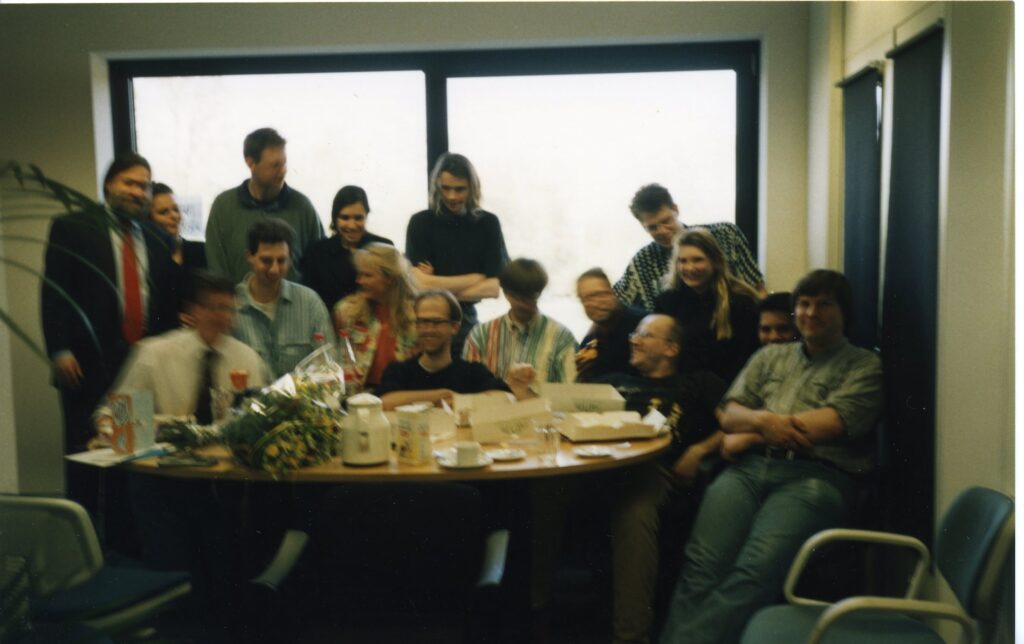Blockchain technology didn’t just come out of thin air – other products, software, and computer scientists paved way for its arrival. Before actually writing about blockchain technology itself I think knowing the history and the series of events that lead to it is also very important. I have reason to believe that Satoshi Nakamoto is not just a person but a group of people. If you dive down the history of blockchain you will see that some of the people that paved the way for its arrival had similar technology with the blockchain. The most glaring one is BitGold. Their protocol was so similar that people thought that Nick Szabo was the anonymous bitcoin creator Satoshi Nakamoto. Below is how it all started.
DigiCash
In 1983, David Chaum, an American computer scientist, and cryptographer founded an anonymous cryptographic electronic money, believed to be the first cryptocurrency to ever exist. This cryptocurrency relied on the use of blind signatures.
A blind signature is a kind of digital signature in which the message is blinded before it is signed. In this, case the signer will not know the message content. Then the signed message will be unblinded. This technology was the brainchild of his company DigiCash. DigiCash deals with finance through electronic money

This innovation lead to the development of blockchain technology because most of the groundwork has been done by them already.
David Chaum established the Digicash company after submitting an outstanding paper on the technology that can be used for anonymous cash transfers in 1982 called Blind Signatures for Untraceable payments.
“You can pay for access to a database, buy software or a newsletter by email, play a computer game over the net, receive $5 owed you by a friend, or just order a pizza. The possibilities are truly unlimited.”
David Chaum while speaking at the first ever CERN conference in Geneva in 1994,
DigiCash users will first needed to withdraw money from their bank account, which would then be changed into Cyberbucks. These would then be stored on the user’s PC hard drive. DigiCash transactions – Users could use DigiCash to pay for goods and service.
DigiCash is an automation of the way we pay for goods using payment systems like banknotes and coins. It also addresses some of its problems such as lack of control, privacy, and security.
The company later declared bankruptcy in 1988 and eventually sold all its assets to another digital currency called eCash Technologies. eCash technologies was eventually acquired by InfoSpace on Feb. 19, 2002. InfoSpace is currently known as Blucora
There were multiple reasons behind the failure of DigiCash. One of which was the lack of cash inflow between the employees and the leadership of the company.
David is currently leading Elixxir and Praxxis to provide scalable digital sovereignty.
HashCash
Hashcash is a proof-of-work system used to limit email spam and denial-of-service attacks. Hascash was developed by Adam Back in the year 1997. He also released a formal documentation in the year 2002 in the paper called “HashCash – A Denial of Service Counter Measure”,
Hash came to the limelight for its role in the development of bitcoin and other cryptocurrencies.
Hashcash appends a textual encoding of Hashcash stamp to the email header of an email to prove that the sender has expended a modest amount of CPU time calculating the stamp before sending the email. Receivers can verify whether a sender made such an investment and use the results to help filter email.
This is based on the idea that if the sender has used their processor to generate this stamp, it is unlikely that they are a spammer. Receivers with a very low almost negligible computational cost can verify this. In this way we can guarantee that it is not spam.
The business of spamming requires you send hundreds and thousands of email so quickly with very low cost of resources per message. If a 8 second job is requested before sending an email, the cost of sending thousands of spam emails wouldn’t be worth it. The receiver can quickly verify if there is a verification work prior to receiving the mail. With this, you can quickly filter and classify legal emails from spam attempts. Bitcoin makes use of the hashcash function as part of its mining core.
B-Money
B-Money is an early age distributed cash system proposed by Wei Dai, a computer engineer known for his contributions to cryptography and cryptocurrencies. He developed the Crypto++ cryptographic library, created the B-money cryptocurrency system, and co-proposed the VMAC message authentication algorithm.

The smallest subunit of Ether, the Wei, was named after him
What Is a Wei? Wei is the smallest denomination of ether—the cryptocurrency coin used on the Ethereum network. One ether = 1,000,000,000,000,000,000 wei (1018).
B-money was proposed by Wei Dai as “Anonymous Distributed Electronic Cash System” in his white paper on the Cypherhunks mailing-list in November 1988. Satoshi Nakamoto referenced b-money when creating Bitcoin.
The idea behind the B-money according to Wei Dai is to create a free financial system on the internet so that no one can introduce taxation and force people to do anything.
For the speedy implementation of B-Money, technical documents like white papers were published, which contained the same basic principles as the modern cryptocurrency.
It was assumed that the digital aliases will be able to send and receive money through a decentralized network and even ensure the implementation of contracts among themselves without the involvement of a third party. Unfortunately, the B-Money project has not moved from the dead-end after the implementation of the white paper.
In his white paper, Wei Dai wrote:
“So I propose an alternative money creation subprotocol, in which account keepers (everyone in the first protocol) decide and agree on the amount of b-money to be created, each period, with the cost of creating that money determined by an auction. Each money creation period is divided up into four phases, as follows,” The first phase is:
- Planning: The account keepers compute and negotiate with each other to determine an optimal increase in the money supply for the next period. Whether or not the account keepers can reach a consensus, they each broadcast their money creation quota, and any macroeconomic calculations are done to support the figures.
- Bidding: Anyone who wants to create B-money broadcasts a bid in the form of <x, y> where x is the amount of B-Money he wants to create, and y is an unsolved problem from a predetermined problem class. Each problem in this class should have a nominal cost (in MIPS-years say) which is publicly agreed on.
- Computation: After seeing the bids – the ones who placed bids in the bidding phase may now solve the problems in their bids and broadcast the solutions.
- Money Creation: Each account keeper accepts the highest bids (among those who broadcasted solutions) in terms of nominal cost per unit of B-Money created and credits the bidders account accordingly.
Apart from the B-Money, Wei Dei is also responsible for many cryptographic techniques such as VMAC (Message Authentication Method) Crypto++, which is a free and open-source C++ class library of cryptographic algorithms and schemes originally written by Wei Dei. Crypto++ is been widely used in academia, students projects, open-source and non-commercial projects -as well as businesses.
e-Gold
e-Gold was a digital gold currency company operated under Gold and Silver Inc. It was founded by Douglas Jackson and Barry Downey in 1996. Before founding the company Jackson was an Oncologist and Barry was working as an attorney. It was one of the earlier companies that tried to establish digital currency, but it used gold and other precious metals, mostly silver as the underlying currency as they are globally acceptable.

e-Gold lets users create an account on their website and deposit money in the denomination of grams of gold or silver mostly and provide instant transfers of gold to other accounts.
Even though the company was just launched in 1996, it was raised to 5million accounts by the end of 2009, when the transfers were suspended because of legal issues that the company was facing during that period. The company was at its peak during the year 2006 with more than $2 billion worth of spending per year which was momentarily equivalent to $71 billion USD.
The company was easily targeted with phishing scams and financial malware by criminal syndicates. e-Gold faced many hurdles such as security issues, digital scams, cyber-attacks, systemic problems as the technology available during the era was primitive. Even though the company was successful, eventually it was shut down – yet it played its part in motivating the need for digital currencies.
During the early 2000s, the feature of immediate settlement implemented by e-gold was recognized and it rose as the key for the emergence of peer-to-peer transactions of digital rights of an asset such as in smart contracts
Bitgold
Bitgold is one of the most known decentralized virtual currency projects taken before blockchain. It was proposed by Nicholas (Nick) Szabo in 1988. Although not implemented, Szabo’s attempt is widely considered and brought into the limelight. He was believed to be the precursor of Bitcoin Developer Satoshi Nakamoto. The bitcoin and bit-gold protocol are so similar that at one point people thought Nick is the anonymous bitcoin creator, Satoshi Nakamoto. Szabo claimed that bit-gold was created to address some of the problems of the traditional finance system.

Szabo believes that
“Participants must have a great deal of trust to make transactions in the traditional system; in other words, we need to be familiar with the other participant with whom we are making a transaction, which places constraints on the system”.
He then decided to act on the constraints and then proposed BitGold, a trustless transaction system. Szabo’s presentation at the bitcoin investors conference sharpens the purpose of Bitgold as software to minimize vulnerabilities of all parties to each other. Bitcoin and Bitgold are almost identical to each other in terms of architecture and transaction system, mainly the decentralized network. Similar to bitcoin a Bitgold user must solve a cryptic puzzle using computer power.
Even the Tesla founder Elon Musk now suspects the relationship between bitcoin and Szabo. In a podcast with artificial-intelligence researcher Lex Fridman, he said that to find Satoshi Nakamoto’s identity, we need to “look at the evolution the ideas” before the launch of bitcoin. Musk suggested that we can see “who wrote about those ideas” and take an educated guess.
Musk said that he is not sure if Szabo is or is not Nakamoto, but the guy certainly “seems to be the one more responsible for the ideas behind bitcoin than anyone else.”
Now you have the general idea on the Predecessors of Blockchain, you can share your thoughts in the comment section below.



I have read so many posts about the blogger lovers however this post is really a good piece of writing, keep it up
Great selection of modern and classic books waiting to be discovered. All free and available in most ereader formats. download free books
whoah this blog is wonderful i really like reading your articles. Keep up the great paintings! You realize, a lot of people are hunting round for this info, you could help them greatly.